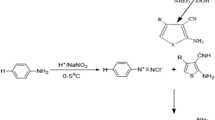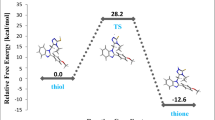Abstract
The aim of this research is to investigate the quantum geometric properties and chemical reactivity of atropine, a pharmaceutically active tropane alkaloid. Using density functional theory (DFT) computations with the B3LYP/SVP functional theory basis set, the most stable geometry of atropine was determined. Additionally, a variety of energetic molecular parameters were calculated, such as the optimized energy, atomic charges, dipole moment, frontier molecular orbital energies, HOMO–LUMO energy gap, molecular electrostatic potential, chemical reactivity descriptors, and molecular polarizability. To determine atropine’s inhibitory potential, molecular docking was used to analyze ligand interactions within the active pockets of aldo–keto reductase (AKR1B1 and AKR1B10). The results of these studies showed that atropine has greater inhibitory action against AKR1B1 than AKR1B10, which was further validated through molecular dynamic simulations by analyzing root mean square deviation (RMSD) and root mean square fluctuations (RMSF). The results of the molecular docking simulation were supplemented with simulation data, and the ADMET characteristics were also determined to predict the drug likeness of a potential compound. In conclusion, the research suggests that atropine has potential as an inhibitor of AKR1B1 and could be used as a parent compound for the synthesis of more potent leads for the treatment of colon cancer associated with the sudden expression of AKR1B1.









Similar content being viewed by others
Data Availability
All data generated or analyzed during this study are included in this article (and its supplementary information file).
References
Chen, J., & Huang, X.-F. (2009). The signal pathways in azoxymethane-induced colon cancer and preventive implications. Cancer biology & therapy, 8(14), 1313–1317.
Bauer, B., et al. (2020). Quantum algorithms for quantum chemistry and quantum materials science. Chemical Reviews, 120(22), 12685–12717.
Chen, J., & Huang, X.-F. (2009). The signal pathways in azoxymethane-induced colon cancer and preventive implications. Cancer biology therapy, 8(14), 1313–1317.
Matsunaga, T., et al. (2012). Aldo–keto reductase 1B10 and its role in proliferation capacity of drug-resistant cancers. Frontiers in pharmacology, 3, 5.
Ruiz, F. X., et al. (2011). Human and rodent aldo–keto reductases from the AKR1B subfamily and their specificity with retinaldehyde. Chemico-biological interactions, 191(1–3), 199–205.
Demirkol Canlı, S., et al. (2020). Evaluation of an aldo-keto reductase gene signature with prognostic significance in colon cancer via activation of epithelial to mesenchymal transition and the p70S6K pathway. Carcinogenesis, 41(9), 1219–1228.
Alam, M., et al. (2018). DFT/TD-DFT calculations, spectroscopic characterizations (FTIR, NMR, UV–vis), molecular docking and enzyme inhibition study of 7-benzoyloxycoumarin. Computational Biology Chemistry, 73, 65–78.
Kaur, R., & Arora, S. (2015). Alkaloids-important therapeutic secondary metabolites of plant origin. Critical Review, 2(3), 1–8.
Devi, R., et al. (2020). Fungal secondary metabolites and their biotechnological applications for human health. New and future developments in microbial biotechnology and bioengineering (pp. 147–161). Elsevier.
Kaur, R., & Arora, S. (2015). Alkaloids-important therapeutic secondary metabolites of plant origin. J Crit Rev, 2(3), 1–8.
Grynkiewicz, G., & Gadzikowska, M. (2008). Tropane alkaloids as medicinally useful natural products and their synthetic derivatives as new drugs. Pharmacological Reports, 60(4), 439.
Kohnen-Johannsen, K. L., & Kayser, O. (2019). Tropane alkaloids: Chemistry, pharmacology, biosynthesis and production. Molecules, 24(4), 796.
Hallcher, L. M., & Sherman, W. R. (1980). The effects of lithium ion and other agents on the activity of myo-inositol-1-phosphatase from bovine brain. Journal of Biological Chemistry, 255(22), 10896–10901.
Mohanlall, V. & Ally, F. (2020). An overview of tropane alkaloids from Datura stramonium L. Journal of Pharmacognosy Phytochemistry, 9(3),5–13
Prieto-Martínez, F. D., Arciniega, M., & Medina-Franco, J. L. (2018). Molecular docking: Current advances and challenges. TIP. Revista especializada en ciencias químico-biológicas, 21(1), 65–87.
Rasheed, M. A., et al. (2021). Identification of lead compounds against Scm (fms10) in Enterococcus faecium using computer aided drug designing. Life, 11(2), 77.
Alam, M., et al. (2018). DFT/TD-DFT calculations, spectroscopic characterizations (FTIR, NMR, UV–vis), molecular docking and enzyme inhibition study of 7-benzoyloxycoumarin. Computational Biology and Chemistry, 73, 65–78.
Frisch, M., et al. (2003). Revision B. Gaussian 03. Gaussian. Inc., Pittsburgh (PA).
Goerigk, L., & Reimers, J. R. (2013). Efficient methods for the quantum chemical treatment of protein structures: The effects of London-dispersion and basis-set incompleteness on peptide and water-cluster geometries. Journal of Chemical Theory Computation, 9(7), 3240–3251.
Tirado-Rives, J., & Jorgensen, W. L. (2008). Performance of B3LYP density functional methods for a large set of organic molecules. Journal of chemical theory computation, 4(2), 297–306.
Dennington, R., Keith, T. A. & Millam, J. M. (2016). GaussView, version 6.0. 16. Semichem Inc Shawnee Mission KS, USA.
Torres, J. A. G., et al. (2019). Low-scaling algorithm for nudged elastic band calculations using a surrogate machine learning model. Physical review letters, 122(15), 156001.
Dennington, R., Keith, T.A. & Millam, J. M. (2016). GaussView 6.0. 16. Semichem Inc.
Channar S. A., et al., (2022). Exploring thiazole-linked thioureas using alkaline phosphatase assay, biochemical evaluation, computational analysis and structure–activity relationship (SAR) studies. Medicinal Chemistry Research, 31(10), 1792–802.
Aziz, M., et al. (2022). Identification of potent inhibitors of NEK7 protein using a comprehensive computational approach. Scientific reports, 12(1), 1–17.
Berman, H., Henrick, K., & Nakamura, H. (2003). Announcing the worldwide protein data bank. Nature Structural Molecular Biology, 10(12), 980–980.
Morris, G. M., et al. (2009). AutoDock4 and AutoDockTools4: Automated docking with selective receptor flexibility. Journal of computational chemistry, 30(16), 2785–2791.
Trott, O., & Olson, A. J. (2010). AutoDock Vina: Improving the speed and accuracy of docking with a new scoring function, efficient optimization, and multithreading. Journal of computational chemistry, 31(2), 455–461.
Belhassan, A., et al. (2021). Camphor, artemisinin and sumac phytochemicals as inhibitors against COVID-19: Computational approach. Computers in Biology Medicine, 136, 104758.
Ouassaf, M., et al. (2021). Combined docking methods and molecular dynamics to identify effective antiviral 2, 5-diaminobenzophenonederivatives against SARS-CoV-2. Journal of King Saud University-Science, 33(2), 101352.
Morris, G. M., et al. (1998). Automated docking using a Lamarckian genetic algorithm and an empirical binding free energy function. Journal of computational chemistry, 19(14), 1639–1662.
Heinzerling, L., Klein, R., & Rarey, M. (2012). Fast force field-based optimization of protein–ligand complexes with graphics processor. Journal of Computational Chemistry, 33(32), 2554–2565.
Visualizer, Discovery Studio. Accelrys software inc. Discovery studio visualizer 2.
Wang, Z., et al. (2016). Comprehensive evaluation of ten docking programs on a diverse set of protein–ligand complexes: The prediction accuracy of sampling power and scoring power. Physical Chemistry Chemical Physics, 18(18), 12964–12975.
Aziz, M., et al. (2022). Identification of NEK7 inhibitors: Structure based virtual screening, molecular docking, density functional theory calculations and molecular dynamics simulations. Journal of Biomolecular Structure Dynamics, 1–15.
Bowers, K. J., et al. (2006). Scalable algorithms for molecular dynamics simulations on commodity clusters. In SC'06: Proceedings of the 2006 ACM/IEEE Conference on Supercomputing. 84.
Ferreira, L. G., et al. (2015). Molecular docking and structure-based drug design strategies. Molecules, 20(7), 13384–13421.
Belhassan, A., et al. (2022). In silico detection of potential inhibitors from vitamins and their derivatives compounds against SARS-CoV-2 main protease by using molecular docking, molecular dynamic simulation and ADMET profiling. Journal of molecular structure, 1258, 132652.
Channar, P. A., et al. (2021). Structural and functional insight into thiazolidinone derivatives as novel candidates for anticancer drug design: In vitro biological and in-silico strategies. Journal of Biomolecular Structure Dynamics, 1–12.
Xiong, G., et al. (2021). ADMETlab 2.0: An integrated online platform for accurate and comprehensive predictions of ADMET properties. Nucleic Acids Research, 49(W1), W5–W14.
Funding
This study was supported by Taif University Researchers supporting project (number TURSP-2020/38), Taif University, Taif, Saudi Arabia, for research resources.
Author information
Authors and Affiliations
Contributions
S.A.E. and G.S.B. devised and supervised the study plan. S.A.E., S.S.A., M.A., and F.S. carried out the molecular docking investigations and DFTs. The MD simulations were performed by S.A.E and M.A. The manuscript write up was carried out by S.A.E., G.S.B., A.A., and S.M.A. All authors read and approved the manuscript for publication.
Corresponding author
Ethics declarations
Ethics Approval
Not applicable
Consent to Participate
All authors were agreed to participate.
Consent for Publication
All authors have approved the last version of the manuscript for its submission.
Conflict of Interest
The authors declare no competing interests.
Additional information
Publisher's Note
Springer Nature remains neutral with regard to jurisdictional claims in published maps and institutional affiliations.
Supplementary Information
Below is the link to the electronic supplementary material.
Rights and permissions
Springer Nature or its licensor (e.g. a society or other partner) holds exclusive rights to this article under a publishing agreement with the author(s) or other rightsholder(s); author self-archiving of the accepted manuscript version of this article is solely governed by the terms of such publishing agreement and applicable law.
About this article
Cite this article
Ejaz, S.A., Aziz, M., Ahmed, A. et al. New Insight into the Pharmacological Importance of Atropine as the Potential Inhibitor of AKR1B1 via Detailed Computational Investigations: DFTs, ADMET, Molecular Docking, and Molecular Dynamics Studies. Appl Biochem Biotechnol 195, 5136–5157 (2023). https://doi.org/10.1007/s12010-023-04411-2
Accepted:
Published:
Issue Date:
DOI: https://doi.org/10.1007/s12010-023-04411-2




